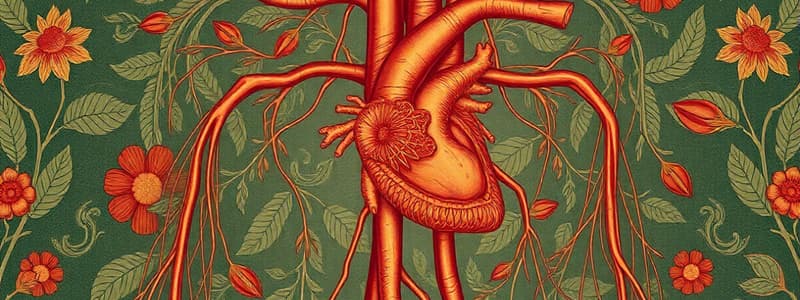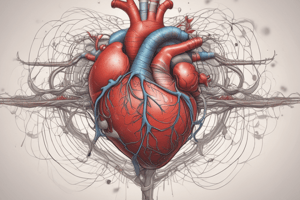Podcast
Questions and Answers
Which of the following is NOT a characteristic of blood?
Which of the following is NOT a characteristic of blood?
During centrifugation, what comprises the buffy coat?
During centrifugation, what comprises the buffy coat?
What is the role of erythropoietin in the process of erythropoiesis?
What is the role of erythropoietin in the process of erythropoiesis?
Which of the following is NOT a type of granulocyte?
Which of the following is NOT a type of granulocyte?
Signup and view all the answers
What is the primary function of platelets in the blood?
What is the primary function of platelets in the blood?
Signup and view all the answers
Which of the following blood types is considered the universal donor?
Which of the following blood types is considered the universal donor?
Signup and view all the answers
What is a differential count in hematology?
What is a differential count in hematology?
Signup and view all the answers
What is the first step in hemostasis, the process of stopping bleeding?
What is the first step in hemostasis, the process of stopping bleeding?
Signup and view all the answers
What is the primary function of the pericardium?
What is the primary function of the pericardium?
Signup and view all the answers
Which of the following is NOT a component of the heart's conduction system?
Which of the following is NOT a component of the heart's conduction system?
Signup and view all the answers
What is the role of intercalated discs in cardiac muscle?
What is the role of intercalated discs in cardiac muscle?
Signup and view all the answers
During which phase of an action potential in cardiac muscle does the plateau occur?
During which phase of an action potential in cardiac muscle does the plateau occur?
Signup and view all the answers
Which of the following is the correct sequence of blood flow through the heart?
Which of the following is the correct sequence of blood flow through the heart?
Signup and view all the answers
Which of the following is a characteristic of the sympathetic nervous system's influence on the heart?
Which of the following is a characteristic of the sympathetic nervous system's influence on the heart?
Signup and view all the answers
What is the primary function of the pulmonary circulation?
What is the primary function of the pulmonary circulation?
Signup and view all the answers
What is the main function of the SA node in the heart?
What is the main function of the SA node in the heart?
Signup and view all the answers
What primary factor contributes to the resistance of blood flow in the circulatory system?
What primary factor contributes to the resistance of blood flow in the circulatory system?
Signup and view all the answers
Which hormone is primarily responsible for increasing blood pressure through fluid retention and vasoconstriction?
Which hormone is primarily responsible for increasing blood pressure through fluid retention and vasoconstriction?
Signup and view all the answers
What is the correct formula for calculating mean arterial pressure (MAP)?
What is the correct formula for calculating mean arterial pressure (MAP)?
Signup and view all the answers
How does blood pressure change in the systemic circulation when resistance increases?
How does blood pressure change in the systemic circulation when resistance increases?
Signup and view all the answers
Which statement correctly contrasts blood pressure in the arteries versus veins?
Which statement correctly contrasts blood pressure in the arteries versus veins?
Signup and view all the answers
What are the five phases of the cardiac cycle?
What are the five phases of the cardiac cycle?
Signup and view all the answers
Which three variables influence stroke volume?
Which three variables influence stroke volume?
Signup and view all the answers
What is cardiac output, and how is it defined?
What is cardiac output, and how is it defined?
Signup and view all the answers
What role do chronotropic agents play in heart rate regulation?
What role do chronotropic agents play in heart rate regulation?
Signup and view all the answers
What are the distinguishing features of capillaries compared to arteries and veins?
What are the distinguishing features of capillaries compared to arteries and veins?
Signup and view all the answers
What process is most significantly involved in the exchange of nutrients and waste in capillaries?
What process is most significantly involved in the exchange of nutrients and waste in capillaries?
Signup and view all the answers
How does the myogenic response help maintain normal blood flow through a tissue?
How does the myogenic response help maintain normal blood flow through a tissue?
Signup and view all the answers
In terms of blood vessel pathways, what distinguishes alternative pathways from simple pathways?
In terms of blood vessel pathways, what distinguishes alternative pathways from simple pathways?
Signup and view all the answers
Flashcards
Total Blood Flow
Total Blood Flow
The volume of blood that circulates through the body in a given period.
Blood Pressure Gradient
Blood Pressure Gradient
The difference in blood pressure between two points in the circulatory system.
Resistance in Blood Flow
Resistance in Blood Flow
A measure of the opposition to blood flow in vessels, influenced by viscosity, length, and radius.
Mean Arterial Pressure (MAP)
Mean Arterial Pressure (MAP)
Signup and view all the flashcards
Renin-Angiotensin System
Renin-Angiotensin System
Signup and view all the flashcards
Platelet response to damage
Platelet response to damage
Signup and view all the flashcards
Coagulation
Coagulation
Signup and view all the flashcards
Intrinsic pathway
Intrinsic pathway
Signup and view all the flashcards
Extrinsic pathway
Extrinsic pathway
Signup and view all the flashcards
Common pathway
Common pathway
Signup and view all the flashcards
Cardiovascular system function
Cardiovascular system function
Signup and view all the flashcards
Heart wall layers
Heart wall layers
Signup and view all the flashcards
Electrical conduction in the heart
Electrical conduction in the heart
Signup and view all the flashcards
Cardiac Cycle Phases
Cardiac Cycle Phases
Signup and view all the flashcards
Cardiac Output
Cardiac Output
Signup and view all the flashcards
Cardiac Reserve
Cardiac Reserve
Signup and view all the flashcards
Chronotropic Agents
Chronotropic Agents
Signup and view all the flashcards
Stroke Volume Influencers
Stroke Volume Influencers
Signup and view all the flashcards
Capillary Structure
Capillary Structure
Signup and view all the flashcards
Net Filtration Pressure (NFP)
Net Filtration Pressure (NFP)
Signup and view all the flashcards
Vasodilator vs Vasoconstrictor
Vasodilator vs Vasoconstrictor
Signup and view all the flashcards
Functions of Blood
Functions of Blood
Signup and view all the flashcards
Components of Centrifuged Blood
Components of Centrifuged Blood
Signup and view all the flashcards
Hematocrit
Hematocrit
Signup and view all the flashcards
Colloid Osmotic Pressure
Colloid Osmotic Pressure
Signup and view all the flashcards
Types of Plasma Proteins
Types of Plasma Proteins
Signup and view all the flashcards
Erythropoiesis Process
Erythropoiesis Process
Signup and view all the flashcards
Granulocytes vs Agranulocytes
Granulocytes vs Agranulocytes
Signup and view all the flashcards
Vascular Spasm in Hemostasis
Vascular Spasm in Hemostasis
Signup and view all the flashcards
Study Notes
Chapter 18: Cardiovascular System: Blood
-
Blood Functions: Blood transports oxygen, nutrients, hormones, and waste products; regulates body temperature and pH; and protects against infection.
-
Six Characteristics of Blood: (and their significance to health and homeostasis)
- High Viscosity: Thick, sticky consistency resists rapid flow
- Temperature: Higher than body temperature, aiding in heat distribution
- Slightly Alkaline pH: Maintains a stable environment for cells
- Volume: Roughly 8% of total body weight, regulating blood pressure and volume
- Color: Red due to hemoglobin, indicating oxygen levels
- Solute composition: Essential for osmotic balance and pH regulation
-
Components of Centrifuged Blood Sample:
- Plasma: Liquid component, primarily water, dissolved proteins, and other solutes.
- Buffy Coat: Thin layer of leukocytes (white blood cells) and platelets.
- Red Blood Cells (Erythrocytes): Dense, red layer containing hemoglobin for oxygen transport.
-
Hematocrit: Percentage of red blood cells in a blood sample. Medical definition differs from clinical usage where hematocrit may not be adjusted for sample volume.
-
Three Formed Elements:
- Erythrocytes: Red blood cells, major component in blood
- Leukocytes: White blood cells, crucial for immune defense, less abundant compared to erythrocytes.
- Platelets: Cell fragments, critical in blood clotting.
-
Colloid Osmotic Pressure: Pressure exerted by plasma proteins; crucial for water balance.
-
Plasma Proteins:
- Albumin: Maintains colloid osmotic pressure, transports hormones, and fatty acids.
- Globulins: Involved in immune functions and transporting various substances.
- Fibrinogen: Essential for blood clot formation.
-
Plasma Solutes: Nutrients, proteins, electrolytes, cellular waste products, gases (oxygen, carbon dioxide).
-
Hematopoiesis: Blood cell formation in red bone marrow. Hematopoietic stem cells differentiate into various blood cell lineages. Colony-stimulating factors (CSFs) are vital.
-
Erythropoiesis: Production of red blood cells in response to oxygen needs. Hormones like EPO (erythropoietin) stimulate erythrocyte production.
-
Leukopoiesis: Formation of white blood cells (granulocytes, monocytes, lymphocytes).
-
Thrombopoiesis: Platelet production.
-
Erythrocyte Structure: Biconcave discs for optimal surface area for gas exchange.
-
Erythrocyte Production Stimulation: Reduced oxygen (low O2) levels
-
Erythrocyte Component Recycling: Breakdown of aged or damaged erythrocytes by the spleen and liver. Hemoglobin components are recycled.
-
Blood Types: Various blood types (A, B, AB, O) based on antigens on red blood cells influence recipient compatibility.
Chapter 19: Cardiovascular System: The Heart
-
Heart Function: Pumps blood throughout the body, driving circulation.
-
Heart Structure and Function: Four chambers (two atria, two ventricles) with valves for unidirectional blood flow
-
Pulmonary vs. Systemic Circulation: Pulmonary circulation carries deoxygenated blood to the lungs and returns oxygenated blood to the heart. Systemic circulation pumps oxygenated blood to the body and returns deoxygenated blood to the heart.
-
Heart Location: Within the thoracic cavity, slightly left of the midline.
-
Pericardium: Double-walled sac surrounding the heart. Surfaces secrete fluid for friction reduction.
-
Heart Wall Layers: Epicardium (outer), myocardium (middle muscle layer), endocardium (inner).
-
Heart Valves: Prevent backflow; Atrioventricular (tricuspid and mitral) and semilunar (pulmonary and aortic) valves).
-
Coronary Arteries: Supply the heart muscle with oxygenated blood.
-
Coronary Veins: Collect deoxygenated blood from the heart muscle.
-
Cardiac Muscle: Intercalated discs allow rapid depolarization, crucial for coordinated contractions.
-
Conduction System: SA node (pacemaker), AV node, bundle of His, Purkinje fibers coordinate heart contraction.
-
Innervation: Sympathetic and parasympathetic systems alter heart rate.
Chapter 20: Cardiovascular System: Vessels and Circulation
-
Blood Vessel Tunics: Intima (inner), media (middle muscle layer), and externa (outer).
-
Arteries vs. Capillaries vs. Veins: Structural differences reflect function; e.g. thicker muscle in arteries, thin walls in capillaries, valves in veins.
-
Capillaries: Sites of exchange between blood and tissues.
-
Veins: Return blood to the heart, aided by valves preventing backflow.
-
Blood Flow in Capillaries: Blood flow is slow for optimal gas and nutrient exchange.
-
Arterial/Venous Pressure: Blood flow is related to the pressure difference between arterial and venous ends of a vessel.
-
Lymphatic System: Assists with fluid balance and plays a role in immune response.
Studying That Suits You
Use AI to generate personalized quizzes and flashcards to suit your learning preferences.
Related Documents
Description
Explore the critical functions and characteristics of blood in Biology Chapter 18. Understand how blood transportation, regulation, and protection mechanisms work to maintain homeostasis. Learn about the components of a centrifuged blood sample and their significance in health.




